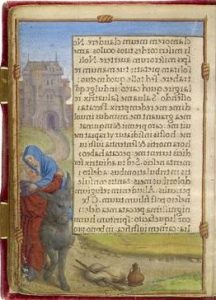The Prayer Book of Claude de France is a very particular manuscript that not only contains religious text but also shows a lot about the environment in which it was created. This prayer book was specially made for Claude of France shortly after she was crowned Queen of France in the early 16th century. According to The Morgan and Library Museum, it was a companion volume to a book of hours made for Claude of France. The distinct illustrations, materials, and size of this prayer book tell us more than we think about who Claude of France was and what purposes it served.

The first distinctive feature of this manuscript is its size. At less than three inches tall and two and a half inches wide (source: The Morgan Library and Museum), it is a palm-sized manuscript; convenient enough to carry around and serve as an accessory. The Morgan Library and Museum stated that during this era, “the smaller the book, the more valuable and jewel-like it became”. Jewelry and decoration during this time period was a prominent way of showcasing wealth and importance. The red velvet binding had gold clasps decorated with the emblem of the French kings. Even closed, the book served as a symbol that represented Claude’s royal background. This simple yet elegant decoration made it fit for a recently crowned queen to carry around and use during short trips.
The pages within the manuscript comprise mostly of Latin text surrounded by religious illustrations. These illustrations and text are all printed on Vellum, a fine type of parchment which is made from the skin of a calf. Many artists and writers struggled to make enough vellum and oftentimes resorted to mixing parchment types, within the same manuscript. The Prayer Book of Claude de France, however, was not a work that could be made from anything but high-quality materials. Even before the writing and illumination of the prayer book had begun, a lot of work had been put into the construction of the vellum leaves that contain them.

The 132 illustrations within the book were created by an artist that was given the nickname “Master of Claude”. These all depict religious scenes that include figures such as Christ, Mary, and Christian saints. Even though books of prayers were generally very decorated, it is to be noted that 132 illustrations is still a very large amount. Many books of hours would only contain embellished letters and decorative borders on some of their folios. The Prayer Book of Claude de France has a very high concentration of religious scenes such as Christ in Gethsemane and the Flight into Egypt. These illustrations were also made from a wide variety of colors. While red and blue are the most common colors, rarer colors such as purple and gold are also present in many of the images. During this time period, rarer colors were harder to create and therefore only used for important and expensive works of art. Both the quality and the quantity of these illustrations were something that could only be found in a manuscript that was meant for the powerful and wealthy.
Since this particular manuscript was made for Claude of France, there are many personalizations within it. The most obvious being the three Claude of France coat of arms that are incorporated into the illustrations. It is a mark of ownership and an assertion of power that she made by including it in an important manuscript. Other, more subtle personalizations, were incorporated into the decorations and selection of scenes. In Folio 24v, a full-page painting of the holy trinity can be found with two men and a dove. The son is depicted as if taking an oath, which can be interpreted to represent Claude’s own coronation and oath. It is clear that this prayer book was for Claude and only Claude. Even the language restricted who was able to use this prayer book. The only people able to read Latin were the very highly educated and wealthy. This prayer book was not like any other prayer book.
While the text within a manuscript may tell us a lot about its purpose, the methods and materials used in its creation can sometimes tell us a lot more. Even without reading the Latin text within The Prayer Book of Claude de France, we were able to identify its value in society and its other purposes. Claude of France was a wealthy woman in a royal family who owned this book to serve as a prayer book and a sort of accessory. The struggles that she had, the people she respected, and many more personal ideas were integrated into this specially made manuscript.
Works Cited